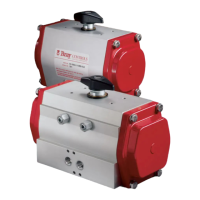3
All information herein is proprietary and condential and may not be copied or reproduced without the expressed written consent of BRAY INTERNATIONAL, Inc.
The technical data herein is for general information only. Product suitability should be based solely upon customer’s detailed knowledge and experience with their application.
Series 92-93 Pneumatic Actuator
Operations and Maintenance Instructions
Fail Open Method 1 – Mounting the Actuator
Perpendicular to the Pipeline
NOTICE
Fail Open Method 1 – Mounting the Actuator Perpen-
dicular to the Pipeline – works only with concentric
disc valves such as the Bray Series 20/21, 22/23 and
30/31 or other valves that allow the disc to be swung
through the seat.
Turn the actuator so the long side is perpendicular
to the pipeline. This will allow the spring cartridges
to rotate the valve stem clockwise to open, and the
air stroke to rotate the valve stem counter-clock-
wise to close. This is the easiest method if there is
sufcient room to mount the actuator.
Fail Open Method 2 – Rotating the Pinion
NOTICE
Fail Open Method 2 – Rotating the Pinion - works only
with concentric disc valves such as the Bray Series
20/21, 22/23 and 30/31 or other valves that allow the
disc to be swung through the seat.
See Assembly (Page 6) for detailed instructions on
reinstalling the travel stop cam on the pinion.
WARNING
Before disassembly of the actuator, the pneumatic
air supply must be completely disconnected from
the actuator, and all compressed air stored within the
actuator must be released. Auxiliary devices connected
to the actuator, such as tubing, ball valves, solenoid
air valves, valve positioners, etc. can block the release
of air from within the actuator. Do not rely upon the
features or controls of any auxiliary device to release
the air from inside the actuator to render it safe for
disassembly.
WARNING
Some actuators may have spring cartridges installed.
Before disassembly, all spring cartridges must be placed
into the relaxed (fully extended) position. All com-
pressed air must be removed from inside the actuator
(See previous warning) and the actuator pinion must
be allowed to rotate so the springs may be relaxed.
Care must be taken to verify that any device connected
to the actuator, such as a valve mounted underneath,
is not preventing the movement of the springs to the
relaxed position.
Remove the end caps, spring cartridges and pistons
from the actuator. Remove the pinion, rotate it 90°, and
reinstall the pinion in the actuator. This will also allow
the spring cartridges to rotate the valve stem clockwise
to open, and the air stroke to rotate the valve stem
counter-clockwise to close. This is the second easiest
method, and allows the actuator to be mounted with its
long side parallel to the pipeline.
Fail Open Method 3 – Reversing the Pistons
NOTICE
Fail Open Method 3 – Reversing the Pistons – works
for all valves, but must be used with offset disc valves
such as the Bray Series 40/41, 42/43 and 44/45, or
other offset disc valves where the disc may only turn
clockwise to close.
See Assembly (Page 6) for detailed instructions on
reinstalling the travel stop cam on the pinion.
Remove the end caps, spring cartridges and pistons from
the actuator. Rotate the pistons so that the racks turn the
pinion counter-clockwise as the pistons move toward
each other. (With the air input ports of the actuator body
facing you, the left hand piston rack should be on the
side with the air ports.) This is the third easiest method,
and allows the actuator to be mounted with its long side
parallel to the pipeline, and clockwise to close rotation
to be maintained.

